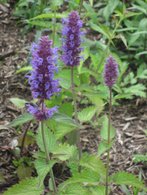Agastache Growing Guide
Agastache (Agastache Foeniculum) is a perennial wildflower native to north-central North America and will do well in USDA Zones 6 to 9. Anise hyssop and licorice mint are common names.
It is in the mint (Lamiaceae) family with large flower spikes that appear in midsummer through fall. Lavender is the most common color, but pink, peach, orange and white can be found.
They reach an average height of 24 to 36-inches and spread 18 to 24-inches.
In addition to being deer resistant it is a nectar plant for butterflies, hummingbirds and pollinators.
Starting from Seed
Follow the seed packet instructions, seeds can be started indoors 6 to 8-weeks before your last expected frost date.
Sow the seeds in a sterile seed starting mix in cell packs or pots. Do not cover the seeds, because they need light to germinate. Press lightly into the soil and keep moist. Germination takes 14 to 30-days.
Bottom watering is the easiest way to keep moist without disturbing the newly sown seeds.
You can direct sow in your flower garden in the late spring to early summer. A large mass planting makes an impressive display.
Dividing the plant in the early spring before new growth begins is the best way to propagate the plant.
For more detailed information visit the seed starting page.
Soil Preparation
Plant in full sun in a nice loose well-drained garden soil. As soon as the soil is frost-free and can be worked, till the soil by digging down 8 to 12-inches turning the soil over with a garden fork. Remove any large rocks and stones. The small stones remaining will do no harm and actually benefit the soil by adding some micronutrients to the soil. They will do best in a slightly acid soil with a pH range of 5.5 to 7.5.
Planting
Agastache should be planted in the late spring after the last expected frost.
Plant 18 to 24-inches apart or in groups of 3 or 5 behind other shorter plants. Dig a hole as deep as the pot and twice as wide. To the soil you just removed add the same amount of good garden soil so you have a nice blend of new and native soil.
Take it out of the pot and gently loosen the root ball pulling away any roots that have grown in a circle around the pot.
Place the root ball in the hole with the growing crown of the plant even with or an inch higher than the surrounding soil. Gently spread out the roots and back fill the hole around the root ball leaving a shallow depression around your plant. Fill the depression with water to settle the soil around the roots adding more soil if necessary and water again. Water daily tapering off as the roots grow and get established.
Watering and Care
Agastache are low maintenance and easy to care for. All you need to do is add a layer of mulch to help retain moisture and keep out competing weeds. It should get an inch of water each week and during dry spells give some water to keep the soil moist. They usually do not need any fertilizer, but a light side dressing of organic fertilizer can be placed around the plant in the spring.
Diseases and Pests
It does not have any serious disease or insect problems. Occasionally powderIy mildew, leaf spot and rust may occur. In wet locations crown rot can be a problem.
Popular Agastache Varieties
Popular varieties: Blue Boa, Blue Fortune, Desert Solstice, Peachie Keen, Pink Pop, Rose Mint, Rosie Posie.
Sources: Burpee, Harris Seeds, Park Seed
Garden Spikes newsletters give you timely information once or twice a month. Subscribe Free to the Garden Times newsletter below.
Your email address will only be used to send you a newsletter and will never be sold. You can unsubscribe at any time.

